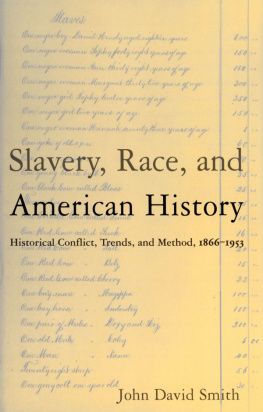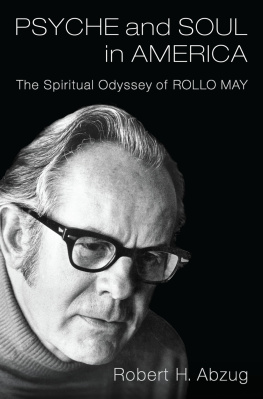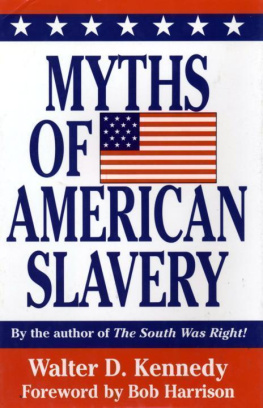NEW PERSPECTIVES ON
Race and Slavery in America
NEW PERSPECTIVES ON
Race and Slavery in America
ESSAYS IN HONOR OF
Kenneth M. Stampp
Robert H. Abzug and Stephen E. Maizlish, Editors
Publication of this book has been assisted by a grant from the Organized Research Fund of the University of Texas at Arlington.
Copyright 1986 by The University Press of Kentucky
Scholarly publisher for the Commonwealth, serving Bellarmine College, Berea College, Centre College of Kentucky, Eastern Kentucky University, The Filson Club, Georgetown College, Kentucky Historical Society, Kentucky State University, Morehead State University, Murray State University, Northern Kentucky University, Transylvania University, University of Kentucky, University of Louisville, and Western Kentucky University.
Editorial and Sales Offices: Lexington, Kentucky 40506-0024
Library of Congress Cataloging-in-Publication Data
Main entry under title:
New perspectives on race and slavery in America.
Includes bibliographies and index.
1. SlaveryUnited StatesAddresses, essays, lectures. 2. Afro-AmericansHistoryAddresses, essays, lectures. 3. United StatesRace relationsAddresses, essays, lectures. 4. Stampp, Kenneth M. (Kenneth Milton) I. Stampp, Kenneth M. (Kenneth Milton) II. Abzug, Robert H. III. Maizlish, Stephen E., 1945-
E441.N5 1986 973.0496073 85-22569
ISBN 978-0-8131-5083-3
In Memory of Arthur Pettit and Robert Starobin
Contents
Robert H. Abzug
Robert McColley
William W. Freehling
William E. Gienapp
Stephen E. Maizlish
Reid Mitchell
Leon F. Litwack
Arthur Zilversmit
James Oakes
John G. Sproat
Joel Williamson
Acknowledgments
Numerous friends and colleagues helped make this book possible. We particularly wish to thank Bob Perkins, Dean of the Graduate School of the University of Texas at Arlington, for his kind generosity; and the Organized Research Fund of the University of Texas at Arlington for its financial assistance. We also appreciate the advice and support of the staff at the University Press of Kentucky and the expert indexing of Nancy Stevens. Patrick Rid-dleberger, a Stampp student himself, deserves special thanks for his aid and encouragement. Finally, our deepest appreciation goes to Kenneth Stampp, whose example of excellence and integrity we honor in this volume.
Robert H. Abzug
Austin, Texas
Stephen E. Maizlish
Fort Worth, Texas
Introduction
ROBERT H. ABZUG
The title New Perspectives on Race and Slavery in America accurately reflects the breadth and limits of the essays presented in this volume, but certainly not of the historian they honor. Kenneth M. Stampp, it is true, remains best known as one of the great historians of slavery. The publication in 1956 of The Peculiar Institution: Slavery in the Ante-Bellum South has been justly credited as a landmark in the rewriting of Afro-American and race relations history. Yet in over forty years of contributions to scholarship, Stampp has ranged over the entire Civil War era. Only by considering the broad vision of his endeavors can one come to appreciate the power and resiliency of his work, as well as the profoundly humane influence he has had on his students and colleagues.
Kenneth Stampps first and central fascination has always been with the Civil Warits causes, its consequences, its mixture of high idealism and grim reality. Writing his doctoral dissertation under William B. Hesseltine at University of Wisconsin, he charted wartime politics in a key northern state in what would later be published as Indiana Politics during the Civil War (1949). Even as his dissertation awaited publication, he was hard at work on a study of Lincoln and the North during the secession crisis. And the War Came (1950) answered those historians who believed that blundering and irresponsible agitators had caused the war. Stampp argued that crucial issues, mostly raised by the existence of slavery, made war probable if not inevitable. He drew a sensitive portrait of Lincoln as he faced the growing crisis, abhorring war but knowing that it might be necessary; at the same time, Stampp demonstrated that the various compromises offered by peacemakers of the secession winter were unrealistic because they left untouched the basic issues dividing the sections.
In neither Indiana Politics during the Civil War nov And the War Came did Stampp pay much attention to issues of race or even to the importance of the antislavery movement, omissions which in retrospect he readily admits. However, the institution of slavery loomed large in his sense of Civil War causation. Without the peculiar institution, he wrote in And the War Came, there could have been no proslavery or antislavery agitators, no division on the issue (whether real or fictitious) of slave territory. And it was to the slave institution that he turned next. Ulrich Phillipss American Negro Slavery (1918) and Lifeand Labor in the Old South (1929) had long been standards in the field. Phillips envisioned slavery as something of a glorious burden for the master, not always showing much monetary reward but encouraging the finer moral instincts of paternalism and allowing the growth of aristocratic sensibilities. In many ways his work, though meeting high standards of scholarship, reflected the values and assumptions of the slaveowners whose lives he painted. He paid relatively little attention to the slaves, caricaturing them as mostly contented and childlike exotics in need of the masters care and control.
Since the 1930s a number of historiansHerbert Aptheker, Richard Hofstadter, and to some extent black scholars W.E.B. Du Bois and John Hope Franklinhad challenged this picture of slavery, but none had provided a thoroughly researched, full-scale reinterpretation. The need for such a work was only underlined by the resurgence of the civil rights struggle after World War II; Phillipss view of the slave seemed at best antiquated and at worst malevolent. The Peculiar Institution more than filled the void. Researched mostly in segregated archives and published two years after Brown v. Topeka Board of Education, it was not only superb history but also a book of and for its time. Stampp forthrightly rejected Phillipss racist tone; instead he assumed the basic irrelevance of race and that slaves were merely ordinary human beings.
Building upon an egalitarian view of the slave and an unsentimental vision of the master, Stampp produced a comprehensive and radically different picture of the institution. He thoroughly documented the cruelty of the system to the slave, describing the work day, punishments, discontent, limitations on family life and cultural expression, as well as diet and health. As for the masters, Stampp stripped them of their paternalistic trappings and saw them basically as owners and managers of a rather profitable system of labor exploitation. In all,










